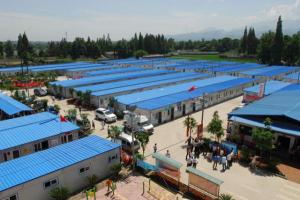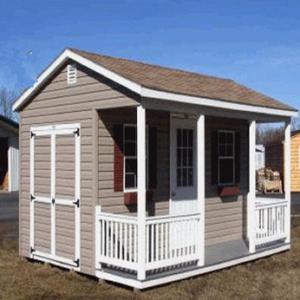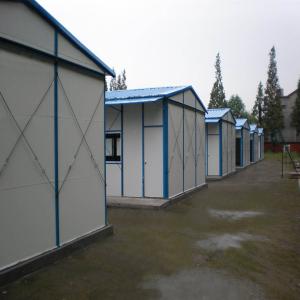Large villa wooden house
- Loading Port:
- China Main Port
- Payment Terms:
- TT OR LC
- Min Order Qty:
- -
- Supply Capability:
- -
OKorder Service Pledge
Quality Product, Order Online Tracking, Timely Delivery
OKorder Financial Service
Credit Rating, Credit Services, Credit Purchasing
You Might Also Like
wooden villa house
1). item No.:EY-V07
2). material: pine wood
3). Good quality with best price
4)Size:OEM or ODM
No pollution during the construction because of using no-toxic green material.
High degree of stiffness and light weight.
Concrete foundation
Earthquake and wind resistance
Natural living environment brings you the happy and healthy life!
if you are interested in this model, please feel free to contact us, and I would like to send you more details about it!
- Q:Do container houses require maintenance?
- Yes, container houses do require maintenance. Like any other type of house, container houses need regular upkeep to ensure their longevity and functionality. This may include routine inspections, cleaning, repainting, and repairs to the structure, insulation, plumbing, and electrical systems. Maintaining a container house is essential to prevent any potential issues and to keep it in good condition over time.
- Q:Are container houses prone to rusting?
- Container houses are generally made from steel, which is susceptible to rusting over time if not properly maintained. However, with proper insulation, regular maintenance, and application of protective coatings, the risk of rusting can be significantly reduced, making container houses less prone to rusting.
- Q:Can container houses be designed with a skylight?
- Certainly! Container houses are absolutely capable of being designed with a skylight. In reality, the inclusion of a skylight in a container house can greatly enhance the amount of natural light and create an atmosphere that feels more open and spacious. Skylights can be integrated into the container house's roof, which allows natural light to pour in from above, filling the interior with brightness and reducing the need for artificial lighting during daylight hours. Moreover, skylights can establish a connection with the outside world, providing breathtaking views of the sky, stars, and even trees, depending on the location and positioning. By employing appropriate design and installation techniques, skylights can be easily accommodated in container houses, making them an exceedingly popular choice for individuals in search of a distinctive and sustainable living space.
- Q:Are container houses suitable for student or workforce housing?
- Yes, container houses can be suitable for student or workforce housing. They are cost-effective, can be easily transported, and can be customized to provide comfortable living spaces. Additionally, container houses are environmentally friendly as they make use of recycled materials.
- Q:Are container houses suitable for individuals who enjoy outdoor living?
- Yes, container houses can be suitable for individuals who enjoy outdoor living. Container houses can be designed with large windows, open floor plans, and outdoor spaces such as decks or patios, allowing individuals to easily access and enjoy the outdoors. Additionally, container houses can be customized to incorporate features like rooftop gardens or outdoor kitchens, enhancing the outdoor living experience for individuals who appreciate spending time outside.
- Q:Can container houses be designed with a sustainable waste management system?
- Yes, container houses can definitely be designed with a sustainable waste management system. One of the key advantages of container houses is their modularity, which allows for easy integration of various sustainable waste management solutions. To begin with, container houses can be equipped with composting toilets, which effectively convert human waste into compost that can be used as fertilizer. Composting toilets require no water and produce no sewage, making them an environmentally friendly option for waste management. In addition to composting toilets, container houses can also incorporate greywater systems. Greywater refers to wastewater produced from non-toilet fixtures such as sinks, showers, and laundry machines. By using a greywater recycling system, this water can be treated and reused for non-potable purposes like flushing toilets or watering plants, reducing the demand for fresh water. Furthermore, container houses can be designed with efficient waste sorting and recycling facilities. Adequate space can be allocated within the house for separate bins to sort recyclable materials such as plastic, glass, paper, and metal. This encourages residents to recycle and reduces the amount of waste sent to landfills. Moreover, container houses can utilize solar panels for energy generation, reducing reliance on traditional power sources. This renewable energy can be used to power waste management systems, such as composting toilets, greywater treatment systems, and recycling facilities. Lastly, container houses can also incorporate sustainable landscaping practices. Rainwater harvesting systems can collect water from the rooftop and direct it to a storage tank for later use in irrigation. This reduces the need for excessive water consumption when maintaining gardens or landscaping around the house. In conclusion, container houses offer ample opportunities for sustainable waste management systems. By integrating composting toilets, greywater recycling, waste sorting and recycling facilities, renewable energy sources, and sustainable landscaping practices, container houses can be designed to minimize waste generation and promote a more sustainable way of living.
- Q:Can container houses be designed with hurricane-resistant features?
- Yes, container houses can be designed with hurricane-resistant features. While shipping containers are inherently strong and durable, additional measures can be taken to ensure their ability to withstand hurricane forces. One key aspect of designing a hurricane-resistant container house is reinforcing the structure to resist strong winds. This can involve strengthening the container walls, roof, and floor by adding additional steel beams or braces. By reinforcing the container, it becomes better equipped to handle the high wind pressures during a hurricane. Another important aspect is securing the container house to its foundation. This can be achieved by using strong anchor systems such as concrete footings or helical piles. Properly anchoring the container house will prevent it from being lifted or moved by strong winds, reducing the risk of structural damage. In addition, designing the container house with hurricane-resistant windows and doors is crucial. Impact-resistant windows and doors, made from materials like laminated glass or polycarbonate, can withstand flying debris and pressure differentials caused by hurricanes. These features ensure that the container house remains intact and keeps its occupants safe during a storm. Furthermore, proper insulation and ventilation systems should be integrated into the container house to prevent water infiltration during heavy rainfall associated with hurricanes. Adequate waterproofing measures combined with proper drainage systems will help to mitigate the risk of flooding or water damage. It is important to note that while container houses can be designed with hurricane-resistant features, no structure can be completely hurricane-proof. The severity of a hurricane and its impact on a container house will depend on various factors such as its location, the strength of the storm, and the quality of construction. However, incorporating hurricane-resistant design features greatly enhances the chances of the container house withstanding the forces of a hurricane and protecting its occupants.
- Q:Do container houses require permits for construction?
- Permits are usually necessary for constructing container houses. The permits needed may differ based on local building codes and regulations. Container houses are often regarded as unconventional housing options in many areas, therefore specific regulations and requirements must be fulfilled to obtain the necessary permits. It is crucial to consult the local building department or planning commission to ascertain the specific permits and approvals needed for constructing container houses in your area. This will guarantee that your project complies with all relevant regulations, building codes, and zoning restrictions.
- Q:Can container houses be designed for accessibility?
- Yes, container houses can be designed for accessibility. With proper planning and modifications, container houses can accommodate the needs of individuals with disabilities or limited mobility. Features such as ramp access, wider doorways, grab bars, and accessible bathroom fixtures can be incorporated into the design to ensure accessibility for all.
- Q:Are container houses safe during earthquakes?
- Container houses can be safe during earthquakes if they are properly designed and built to withstand seismic forces. The safety of container houses during earthquakes depends on various factors such as the structural integrity of the containers, the foundation they are placed on, and the overall construction techniques used. Container houses can be reinforced to make them more resistant to earthquakes. Additional steel reinforcements can be added to the containers' corners and walls to increase their structural strength. These reinforcements help distribute the seismic forces evenly throughout the structure, reducing the risk of collapse during an earthquake. Moreover, the foundation on which the container house is placed plays a crucial role in its earthquake safety. A strong and properly designed foundation can help absorb and dissipate seismic energy, minimizing the impact on the structure. It is essential to ensure the container house is securely anchored to the foundation to prevent it from sliding or toppling over during an earthquake. Additionally, the construction techniques used in building container houses should comply with local building codes and regulations. Adequate insulation, fireproofing, and proper electrical and plumbing installations are also essential for the safety and functionality of the house. It is important to note that no structure can be completely immune to the destructive forces of a severe earthquake. However, with proper design, construction, and adherence to safety standards, container houses can provide a safe and durable living space during seismic events. Consulting with structural engineers and following local guidelines can help ensure the safety of container houses in earthquake-prone areas.
1. Manufacturer Overview |
|
|---|---|
| Location | |
| Year Established | |
| Annual Output Value | |
| Main Markets | |
| Company Certifications | |
2. Manufacturer Certificates |
|
|---|---|
| a) Certification Name | |
| Range | |
| Reference | |
| Validity Period | |
3. Manufacturer Capability |
|
|---|---|
| a)Trade Capacity | |
| Nearest Port | |
| Export Percentage | |
| No.of Employees in Trade Department | |
| Language Spoken: | |
| b)Factory Information | |
| Factory Size: | |
| No. of Production Lines | |
| Contract Manufacturing | |
| Product Price Range | |
Send your message to us
Large villa wooden house
- Loading Port:
- China Main Port
- Payment Terms:
- TT OR LC
- Min Order Qty:
- -
- Supply Capability:
- -
OKorder Service Pledge
Quality Product, Order Online Tracking, Timely Delivery
OKorder Financial Service
Credit Rating, Credit Services, Credit Purchasing
Similar products
New products
Hot products
Related keywords





























